qumefox
0
- Joined
- Mar 26, 2010
- Messages
- 3,221
- Points
- 63
Um. Are you talking about a modflex or a microflex? SMD capacitors seldom have stripes.. much less two lines of text. heh. Your lucky when you get 3 digits on them.

Follow along with the video below to see how to install our site as a web app on your home screen.
Note: This feature may not be available in some browsers.



the output cap is the black thing with a white line on one side and it theres two lines of reading 100 and 6V. you usually blow the cap when theres power applied to the driver without a load.

Hmmm. My green ones from e-electronics fall right into the step on qume's host. I actually have negaive contact problems because of this. The lack of press fit doesn't give the edge of the board enough negative host contact.I got my new CU one today, so well see how the driver fits in that one.
Almost never will - you pretty much always need to bridge the edge and the host with a bit of solder (a wide bridge, and hopefully in multiple positions around the edge).

